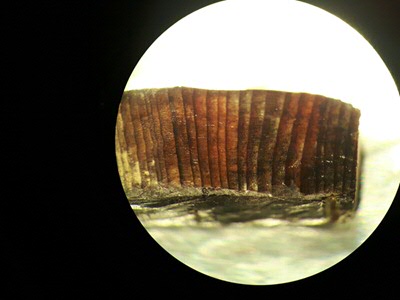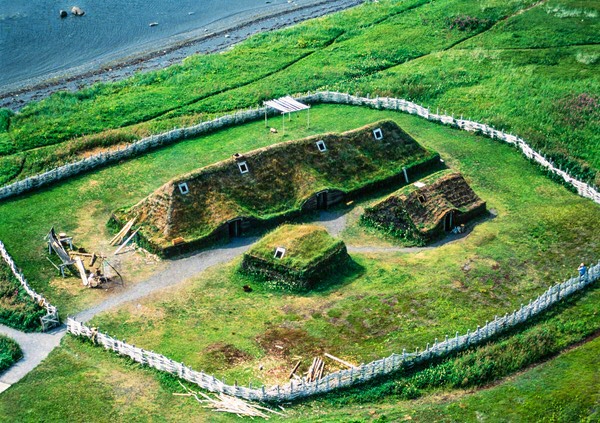Europeans in the Americas 1000 years ago
Columbus was not the first European to reach the Americas. The Vikings got there centuries beforehand, although exactly when has remained unclear. Here, scientists of the University of Groningen and an international team of collegues, show that Europeans were already active in the Americas in 1021 AD. The article Evidence for European presence in the Americas in AD 1021 has recently been published in Nature.
The Vikings sailed great distances in their iconic longships. To the west, they established settlements in Iceland, Greenland and eventually a base at L’Anse aux Meadows, Newfoundland, Canada. However, it has remained unclear when this first transatlantic activity took place. Here, scientists show that Europeans were present in the Americas in 1021 AD - precisely 1000 years ago this year. This date also marks the earliest known point by which the Atlantic had been crossed, and migration by humankind had finally encircled the entire planet.

A Solar Storm Solution
In this study, the chopping of wood by Vikings at L'Anse aux Meadows was dated to exactly the year 1021 AD. The three pieces of wood studied, from three different trees, all came from contexts archaeologically attributable to the Vikings. Each one also displayed clear evidence of cutting and slicing by blades made of metal - a material not produced by the indigenous population. The exact year was determinable because a massive solar storm occurred in 992 AD that produced a distinct radiocarbon signal in tree rings from the following year.

Isotope Chronology
"The distinct uplift in radiocarbon production that occurred between 992 and 993 AD has been detected in tree-ring archives from all over the world" says Associate Professor of Isotope Chronology Michael Dee (Energy and Sustainability Research Institute Groningen (ESRIG), University of Groningen), director of the research. Each of the three wooden objects exhibited this signal 29 growth rings (years) before the bark edge. "Finding the signal from the solar storm 29 growth rings in from the bark allowed us to conclude that the cutting activity took place in the year 1021 AD" says Margot Kuitems (ESRIG, University of Groningen), first author of the paper.

How Far, How Often?
The number of Viking expeditions to the Americas, and the duration of their stay over the Atlantic, remain unknown. All current data suggest that the whole endeavour was somewhat short lived, and the cultural and ecological legacy of this first European activity in the Americas is likely to have been small. Nonetheless, botanical evidence from L'Anse aux Meadows has confirmed that the Vikings did explore lands further south than Newfoundland.
The Sagas
1021 AD is the earliest year in which European presence in the Americas can be scientifically proven. Previous dates for the Viking presence in the Americas have relied heavily on the Icelandic Sagas. However, these began as oral histories and were only written down centuries after the events they describe. Whilst contradictory and at times fantastical, the Sagas also suggest encounters occurred, both violent and amiable, between the Europeans and the indigenous people of the region. However, little archaeological evidence has been uncovered to support such exchanges. Other medieval accounts also exist, which imply prominent figures on the European mainland were made aware the Vikings had made landfall across the Atlantic.

Summary
The Vikings were active in North America in the year 1021 AD. This now represents the earliest – and only – known year in which Europeans were present in the Americas prior to the arrival of Columbus in 1492 AD. It also represents a definitive point in time by which the Atlantic Ocean had been traversed and human migration had finally encircled the globe.
| Last modified: | 21 October 2021 1.27 p.m. |
More news
-
21 November 2024
Dutch Research Agenda funding for research to improve climate policy
Michele Cucuzzella and Ming Cao are partners in the research programme ‘Behavioural Insights for Climate Policy’
-
13 November 2024
Can we live on our planet without destroying it?
How much land, water, and other resources does our lifestyle require? And how can we adapt this lifestyle to stay within the limits of what the Earth can give?
-
13 November 2024
Emergentie-onderzoek in de kosmologie ontvangt NWA-ORC-subsidie
Emergentie in de kosmologie - Het doel van het onderzoek is oa te begrijpen hoe ruimte, tijd, zwaartekracht en het universum uit bijna niets lijken te ontstaan. Meer informatie hierover in het nieuwsbericht.
